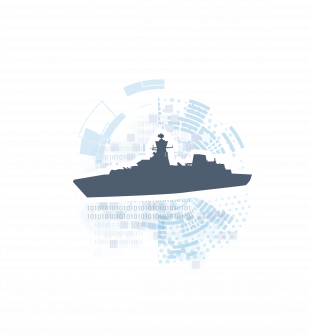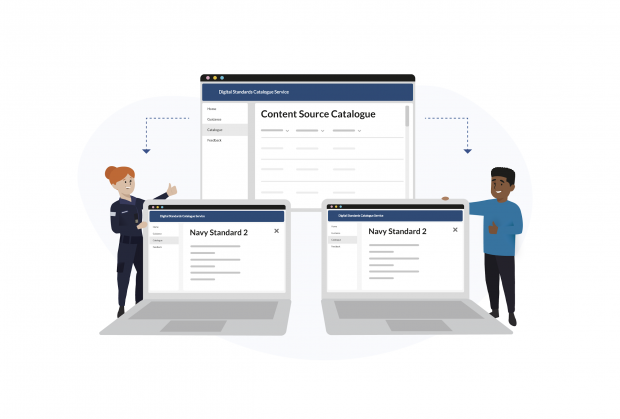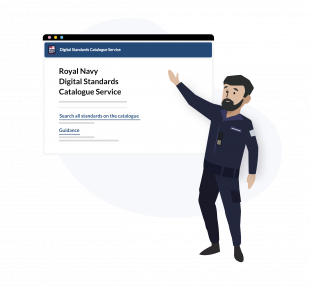In our modern world, digital transformation can be a complex activity. In some areas it's clear what needs to be done, in others you need to first set up the conditions for success before you start to see the change you need. Having the right data when you need it and in a secure manner is at the heart of everything the Navy does and stand ards can make that happen.
ards can make that happen.
In July 2020, Navy Digital set up its Standards team to improve the use of standards across the Royal Navy for the design, build and running of its digital services. This is a key step on the Royal Navy’s journey to become a fully digital Navy by 2023 which is a priority laid out in the Navy’s Digital and Data Strategy. Our team is a blend of Technical Architects and User Researchers to understand requirements of users and how people engage with content. Our mission is to improve adoption of Digital Standards across the Royal Navy and this service is a key step in achieving it.
Let’s cover what we actually mean by Digital Standards. These include a broad range of documents, processes or ways of working. They could be a recognised standard from governing bodies or they could be industry specific such as a Defence Standard. On the other hand, they could be more local so something that a specific project adopts or even recommended best practice such as a certain way of coding.
In order to achieve our mission of improving the adoption of standards, we are focused on three main objectives:
- create and maintain a centralised view of what standards are used for the delivery of digital services in the Navy
- communicate and share existing standards to improve their adoption
- identify what ‘good’ looks like in the long term for Digital Standards and identify ways to achieve it

Although standards might not be the first thing that comes to mind when you think of digital transformation, they are the critical foundation to ensure that all of the exciting projects going on across the Navy are aligned and able to integrate together. Standards mean greater collaboration across Defence which is essential when we are conducting operations alongside our international partners and NATO. By everyone using similar methods, tools and best practices, the Navy can more effectively use its resources and time. Also, standardising the interfaces between applications and processes can drive innovation.

The need for standardisation across the Navy is simple, to be more effective and deliver digital solutions at pace and scale, it is easier to do if everyone is on the same page. If we are all talking the same language and using the same tools, the ability to interconnect is made much easier. With this ambition in mind, the Standards Team has created a Digital Standards Catalogue Service to make standards more accessible for the teams that build digital services for the Royal Navy.
Creating a Digital Standards Catalogue Service
The catalogue service offers a curated and maintained list of the most common standards used in the delivery of digital services and has been built with users, for users. It has complementary guidance to help users find what they need and the ability to share comments and insights about each standard.
In our service, we included the definition of standards, any guidance, mandatory or non-mandatory requirements, specifications or best practice examples. In other words, we have focused our attention on everything that is actually used to improve standardisation instead of only looking at what is mandated.
The service has been specifically designed to help users find the right standards quickly and to help new team members build up Defence-specific knowledge when joining a new project.
For example, the service could be used to find the most commonly used standards to design software architecture or what’s required for an application to connect to the MOD network. In order to make the users’ life easier and the standards more accessible, the content of the catalogue is classified by topics such Technology (architecture, data, systems engineering), Processes (assurance, commercial) or Regulatory. For each of the standards in the catalogue users can also find a short description and a number of supporting details such as classification, whether it is mandatory or not, latest version and much more.
It is by no means a one stop shop and will likely never be, the difference with the Digital Standards Catalogue Service is that the standards have been carefully selected and reviewed to ensure they only contain the most relevant for delivery of Royal Navy digital services.

Discovering the current landscape
In order to create our service with users in mind, our initial efforts were dedicated to identifying and understanding how Standards are used within the Navy during an initial discovery phase. This phase had three main objectives; to find out 1) what standards were being used, 2) who was using them and 3) what their needs were.
We conducted our discovery with civil servants and military personnel from across the Navy, Defence Digital, Defence Equipment and Support (DE&S) and wider MOD who interact with Digital Standards and could tell us their experience. After multiple interviews and extensive analysis, we produced a report that detailed our findings and showed us where to focus first.
One of the first tasks which was to define what a Digital Standard was and then once we were all on the same page, we could focus on identifying our user community. This boiled down to being anyone that is involved in the design, build or running of digital services for the Royal Navy. This includes some outside of the Navy such as DE&S who help buy the equipment or Defence Digital to own some of the Defence Standards and they all have a number of different needs.
Our users are varied with some knowing exact standards and some wanting further guidance on where to go first. The major findings from our research was that our Royal Navy users wanted all the standards specific to them in one place so off we went to ensure this need was met. We have also found out that more than three quarters of the standards used in the delivery of service are not owned by the Navy, making it difficult to have control over what is delivered.
Next Steps

From our user research to delivering a service, the next steps are to share, learn and develop further. There is still much to learn from users in a variety of roles across Defence who are using standards in their work. We are focused on getting feedback to improve and iterate the site as well as finding ways to improve how users can find the standards they need in their day to day jobs.
If you want to find out more then please get in touch, we would like to chat with you. Say hello to us at: navydigital-standards@mod.gov.uk
Leave a comment